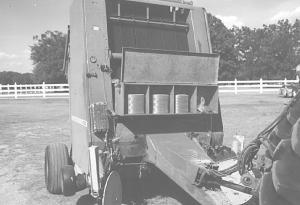1996 - Volume #20, Issue #5, Page #06
[ Sample Stories From This Issue | List of All Stories In This Issue | Print this story
| Read this issue]
Never Miss Twine Monitor Made From Bicycle Generators
 |
 |
 |
"It takes the guesswork out of knowing when to stop the tractor to tie the bale," says Cathey. "I've made more than 6,000 bales with it with no problems. The light on the original monitor turns solid as soon as the baler's tie arm is activated. The problem is that I don't know when to stop the tractor unless I happen to see the light the moment it turns solid. If I don't see it turn solid, hay keeps pouring into the bale which fouls up the tying process.
"My monitor delivers both a beeping noise and a flashing orange light to let me know when to stop the tractor. It lets me make bales that are more uniform in shape because it lets me know exactly when I should stop the tractor without having to worry that I won't see the warning light come on. The monitor has virtually eliminated missed ties which speeds up my baling operation."
Cathey made two other modifications that speed up baling - he added a second twine tie arm to the baler (off a Deere 435) and he mounted a 4-spool twine box on front of the baler.
The bike generators originally had a small steel wheel that ran against the bike tire to generate power. Cathey mounted a pair of large washers about 1/4 in. apart on each wheel and mounted the genera-tors on front of the baler. Twine to each twine tie arm is threaded through the washers on each generator unit. The generators are wired to a 3-light Radio Shack monitor in the tractor cab. The monitor has a pair of yellow lights - one for each twine - on either side of an orange light. The orange light and buzzer are wired to a microswitch on one of the twine-tie arms.
As soon as the tie arms start to swing out they trigger the microswitch which causes the buzzer to sound and the orange light to flash on and off. The yellow lights go on as soon as the arms start tying. "By the time I stop the tractor the arms have started tying the bale. If one or both of the lights don't come on I know that the bale has failed to tie and that I have to get off the tractor to see what's wrong," says Cathey. "After the arms are done tieing the bale they swing back and just before they reach the twine cut-off position the switch is tripped again and the buzzer sounds, letting me know that I should look at the yellow lights again to make sure they're still on so I know the bale has been tied. The lights go off as soon as the twine has been cut."
Contact: FARM SHOW Followup, Tom Cathey, Box 95, Covington, Texas 76636 (ph 817 854-2333).

Click here to download page story appeared in.

Click here to read entire issue
To read the rest of this story, download this issue below or click here to register with your account number.




